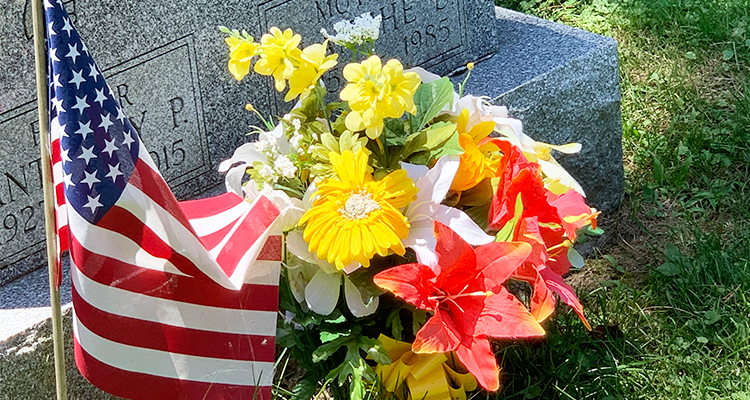But this year’s haiku contest winner — who also took second-place honors — learned enough about our city from his Croatian friends, who did visit Wheeling, to write two stunners.
 For Weelunk’s second annual haiku contest, we asked writers to share what Wheeling 250 brought to mind as our city celebrates its Sestercentennial.
For Weelunk’s second annual haiku contest, we asked writers to share what Wheeling 250 brought to mind as our city celebrates its Sestercentennial.
Some writers reflected on the past; others contemplated the future. Third-place winner Jack Poling — who has never submitted poetry to a contest — wrote about Wheeling’s iconic Suspension Bridge.

“The inspiration for the poem is the memory of riding bikes with my sister across the bridge when we were 8 or 9 years old. It’s a weird feeling, and a little scary, being able to see through the grid down to the river. My sister has since passed on, so that memory is very special,” Poling said.
Poling describes himself as “an avid reader and infrequent writer. I especially enjoy the poetry of Walt Whitman. This is the first time I’ve ever submitted poems to anyone,” he said. The life-long Bridgeport, Ohio, resident, is retired from the Ohio Army National Guard and, added, “I currently have the best job in the world as manager of the Wheeling Hampton Inn.”

From his home in Croatia, via email, Gatalica told Weelunk: “I have friends who visited Wheeling in West Virginia, and I read many books about Wheeling’s rich history. During the years, I learned many things about Wheeling. I wanted to celebrate Wheeling’s 250 and its rich history through haiku form. … I thought it would be great to celebrate Wheeling’s bright future in this way.”
Gatalica found out about the haiku contest by way of Weelunk’s website, he said. And because Wheeling inspired him, he decided to enter the contest.
Gatalica recently won the Basho International Haiku Competition with this haiku:
thinking of war
wrapped in barbed wire
fragile butterfly
You can view Gatalica’s haiku profile on The Haiku Foundation’s website.
We congratulate our winners and thank everyone who submitted a haiku.
We also thank judge Earl Randal Keener who spent much time on making his choices and offered thoughtful comments to the winners.
Keener’s work has appeared in haiku publications throughout the world. His awards in the genre are too numerous to list but include: first place in the 2001 Shiki International Haiku Contest resulting in a month in Japan as the guest of the Ehime Cultural Center in Matsuyama, Japan; gold prize in Ito En Tea International Haiku Contest 2011, 2012, 2015, 2018; Kumamoto City of Artesian Waters Haiku Award 2012; and first place Haiku Canada 2011. Recent awards include British Haiku Society H.M.2018 and W.Va. Writer’s Competition prize for Short Poetry 2018. Keener also was the recipient of the Westmoreland Arts Festival Poetry Award for 2018.
He has conducted workshops at Bethany College, Wheeling Jesuit University and the University of South Carolina, and was a guest lecturer at the Pearl S. Buck Foundation Cal Price Lecture Series, 2018. Some of his publication credits include Wild Sweet Notes — Fifty Years of West Virginia Poetry, Penumbra, Antietam Review, West Branch, Lyrical Passion, The Heron’s Nest, Genjuan Haibun Anthology, Sandberg-Livesay Anthology, Quarried, San Pedro Review and Shukan Seikasu (New York Japanese Weekly).
“There is much information available via the internet on the history and evolution of haiku as well as scholarly studies on how the genre’s transplantation into diverse languages has necessitated a new understanding of the form,” Keener said.
“I would encourage the renewal or updating of our preconceived notions. It is more than a parlor game and more than a measured bridle or bit to impose on a foreign tongue. One might begin by checking the recently updated British Haiku Society submission guidelines. For those who cannot break the chain of forged dogma, I highly recommend the 4,000 haiku of Richard Wright. And the more recent contributions of Billy Collins. For those who are interested in sharpening haiku muscles, check out Tim Russell’s haiku exercise on the internet.
“It was an honor and a privilege, as well as a pleasure to judge this year’s submissions,” Keener added.
Here are the winning works and the judge’s comments:
FIRST PLACE: Goran Gatalica
Wheeling’s heritage —
the Greenwood Cemetery
full of night embers
Keener: “Night embers” threw me at first, and I thought, stars? Votive lights? Fireflies? And suddenly some invisible force in this haiku sprouted in my head (with the help of an android). It’s flowers. A type of daylily, often blood red. What a force haunts this haiku! Everyone who knows Greenwood Cemetery knows that it is breathtaking and thought-provoking, not just for representing what and whom time has taken away, but for its park-like, natural stonework and somber beauty. “Heritage” — is what continues to be bequeathed — the night embers, the more-than-metaphorical daylilies, the continuous contribution of the past to the present that keeps our region’s ideals — our home fires — burning (not an easy task in the blustering winds of current politic, but perhaps it has always been so). A classic wabi/sabi is presented in this haiku along with a wedding of contradictory themes that is very much in the spirit of Zen and Shinto sensibility, not to mention the bushido virtue of honoring what is and what has come before. The choice of flowers too, imparts a haiku seasonality (kigo), lending integrity to an experience of time and place.

SECOND PLACE: Goran Gatalica

Wheeling’s bright future —
inside my son’s new ball glove
many shooting stars
Keener: It was a close call between this haiku and the first-place selection. “Bright” is a judgment, a civic advertisement for a future that cannot be guaranteed. The presentation, I felt, would be much stronger, more honest, natural, logical and graceful without it. But, of course — in this application 5-7-5 is a prerequisite … even so and despite my quibble, it is apparent this haiku is positing wishes as opposed to assertions; a future we all hope is bright. The wish is both personal and all-encompassing, one’s children, one’s city, one’s world. I can hear the crack of a bat and the smack of a ball into leather. I seem to recall a baseball glove from my youth that was inked by the manufacturer with shooting star logos. It may also be that the “shooting stars” here are mostly symbolical — baseballs not yet caught or even more likely the wishes made by parent and son for a bright and successful future. Or even something inked by the child’s own hand. Despite an inversion of syntax that could be easily reversed, this is a fine haiku. It is often the uncertainty of a haiku, the craft of allowing space for a reader’s imagination to wander that makes the little atom of poetry bigger than the sum of its parts; for the haiku (when successful), like the Tardis is so much bigger on the inside than the outside, encompassing the capricious and flexible measure of the human soul.
THIRD PLACE: “Suspension Bridge” by Jack Poling
Hummm … bike tires on steel
Glance down … glimpsing … river far
below your pedals
Keener: I chose this for the charm of its Joycean stream of consciousness and the onomatopoeic hum/om. Also, because of my own predilections. Also because I feel there is a fine haiku lurking here, but one not captured in the warp and woof of this framework.

• After nearly 38 years as reporter, bureau chief, lifestyles editor and managing editor at The Times Leader, and design editor at The Intelligencer and Wheeling News-Register, Phyllis Sigal has joined Weelunk as managing editor. She lives in Wheeling with her husband Bruce Wheeler. Along with their two children, son-in-law and two grandchildren, food, wine, travel, theater and music are close to their hearts.


